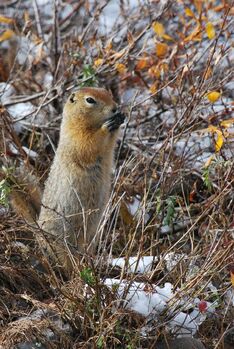
Overview: My research interests focus on the adaptations animals have to their natural environment. They are broad, overlap, and range from the individual to the ecosystem and from population demography and life history to hormonal and brain mechanisms. Proposing hypotheses and performing experimental tests are critical. Collaborators and students are key. Methods and technical papers have also advanced the field. For each section, I list some of the publication numbers from the Publications section. [email protected]
Population Regulation and Limitation: What factors regulate animal populations? These range from spacing behavior within a species, to top-down control by their predators or parasites, to bottom-up limitation by food. These vary by species and by community. Life-history is shaped by these forces. We have carried out intensive research on this fundamental research area and continue to do so. The publications span my career, from my early ones (#1-12) to present papers (e.g. 216, 231, 233, 237, 242, 250, 252, 255, 259, 260) and include our book - the Ecosystem Dynamics of the Boreal Forest. The Role of the Stress Axis: The stress axis is a vital regulator of adaptation in birds and mammals and a pivotal component of the neuroendocrine system. The system is a major pathway that integrates environmental change and through which life history decisions to reproduce, grow, or put energy into storage are implemented. Its functioning affects a wide range of interrelated biological processes, including the rate of aging, life history traits and reproduction, the immune system, behavior, and the rate of neurogenesis. We have now published extensively on a broad range of wild mammal species and some bird species on: social behavior (51, 189, 202, 203, 207, 212, 238, 259), predation risk (e.g. 71,109,129,130,132, 138,160,170,192,195,209,231), and species-specific adaptations to their environments (e.g. 84,91,95,97,145,147,226). Major synthetic reviews have advanced the field (110,120,137,144,154,156,158,161,165, 191). We have published rigorous measurement methods for plasma, feces, and hair (e.g. 133,136,150,155, 172, 187, 212, 217, 225, 257). I spear-headed the Ecology of Stress special feature in Functional Ecology in 2013 (11 papers). Maternal Effects and Epigenetics: Variation in environmental conditions and stressors can cause intergenerational programming operating through maternal effects. This can occur through the mother both in utero and post utero during lactation. These can affect fitness and, if all individuals in the population experience similar conditions (as in cyclic lemmings, voles and snowshoe hares) the dynamics of the entire population. We have studied maternal effects by examining heritability (33,36,97), breeding performance of voles from different cycle phases (44), the role in snowshoe hare cycles (129,170), and epigenetics (233, 259). We have published reviews in natural populations (70, 184, 232, 237, 244). Aging: Aging is one of the fundamental problems of modern biology. Aging processes may play a significant role in the population demography (56, 70) and life history of mammals and how these are influenced by reproduction, predation risk, and social stress. Though a number of key processes deteriorate with age, we have found that the stress axis does not and is key throughout life (166, 171, 263). Climate and Climate Change: Our research has helped to unravel the responses of species, communities, and ecosystems to past and present climate (110). The boreal forest ecosystems in North America and western Eurasia are driven ultimately bottom up by climate (181). Climate change is having dramatic effects on plants (124,181,199) and mammals (169, 173, 183, 199, 205, 214, 226, 231, 249, 254, 256, 258). Nonbreeding Territoriality in Mammals: Territoriality during the breeding season has major physiological costs. Some species are also territorial during the nonbreeding season. To avoid those costs during the nonbreeding season, they use a prohormone (DHEA) that only causes aggressive behavior. We have studied this in red squirrels (123), marten (200), and American pikas, eastern cottontail rabbits, and snowshoe hare (250) and written one major review (168). Neurogenesis: The formation of new neurons in the adult brain continues until death. It occurs in two areas – the dentate gyrus of the hippocampus and the subventricular zone which gives rise to neurons for the olfactory bulb. The hippocampus is of critical importance in memory and stress. We have studied this in wild species (114, 135), had three reviews (98, 121, 146), and a major technique paper (100). |





